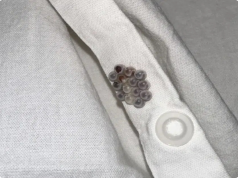In a scene that seems ripped from a sci-fi horror movie, eerie-looking rabbits with grotesque facial growths have been spotted hopping through neighborhoods in Fort Collins, Colorado — their once-adorable faces now marred by dark, horn-like protrusions that resemble twisted tentacles or alien appendages.
Photos shared by alarmed locals show cottontail rabbits with black, spiky tumors sprouting from their ears, mouths, and eyes — earning them nicknames like “Frankenstein bunnies” and “zombie rabbits.”
But this isn’t a viral prank or a Stranger Things crossover.
It’s a real — and increasingly common — wildlife phenomenon caused by a virus that’s turning wild rabbits into real-life “jackalopes.”
🐰 Meet the ‘Jackalope’ Virus: Cottontail Papilloma Virus (CRPV)
The culprit behind these nightmarish growths is the Cottontail Rabbit Papilloma Virus (CRPV) — a naturally occurring virus that causes benign skin tumors in wild rabbits.
While the tumors may look like something out of H.P. Lovecraft’s nightmares, they’re actually a well-documented biological condition that has fascinated scientists for decades.
According to ScienceDirect, CRPV is a papillomavirus that causes cutaneous papillomatosis — a condition marked by:
- Rough, wart-like, keratinized growths
- Often pigmented or blackened
- Found on the ears, eyelids, neck, shoulders, and face
These tumors can grow several inches long and often appear in clusters — giving infected rabbits an otherworldly, antlered appearance.
🧪 What Causes the ‘Tentacles’?
The virus works by hijacking the rabbit’s skin cells, forcing them to rapidly multiply and form fibropapillomas — fleshy, horn-like tumors made of keratin (the same protein found in human hair and nails).
The progression typically follows three stages:
- Red, raised bumps appear on the skin
- Bumps grow into wart-like masses
- Tumors darken and harden into black, tendril-like projections that can cover the mouth, eyes, or ears
While most tumors are non-cancerous, in rare cases, they can transform into squamous cell carcinoma — a form of skin cancer that can be life-threatening for the animal.
🦟 How Is CRPV Spread?
Unlike many viruses, CRPV is not spread through direct contact between rabbits.
Instead, it’s transmitted by blood-feeding insects — particularly:
- Mosquitoes
- Ticks
- Fleas
When an insect bites an infected rabbit, it picks up the virus and carries it to the next host.
This means the virus can spread quickly during warm months when insect populations surge.
Experts warn that as climate change extends mosquito seasons and alters wildlife patterns, CRPV could spread beyond Colorado into other parts of the Midwest and Western U.S.
❌ Is It Dangerous to Humans or Pets?
Good news:
👉 CRPV is not contagious to humans, dogs, or cats.
The virus is species-specific — it only affects cottontail rabbits and a few other lagomorphs.
You can’t catch it from touching a rabbit or being near one.
However, Colorado Parks and Wildlife (CPW) still urges the public to avoid contact with infected animals.
Why?
- The rabbits may be in pain or distress
- They could carry other diseases (like tularemia)
- Handling wildlife is always risky and often illegal
📢 CPW Statement:
“If you see a rabbit with these growths, do not approach or handle it. Report sightings to local wildlife authorities.”
🐇 What Happens to Infected Rabbits?
For many rabbits, the tumors are not immediately fatal — but they can severely impact quality of life:
- Tumors around the mouth can make eating difficult
- Growths near the eyes or ears can impair vision and hearing
- Secondary infections or cancer can develop
- Predators may target weakened animals
In some cases, the immune system clears the virus, and the tumors fall off on their own — but this can take months, and not all rabbits survive.
🚨 Should You Be Worried?
While the sight of a tumor-covered rabbit is unsettling, there’s no need for public panic.
This is a natural wildlife disease, not a biohazard.
It doesn’t threaten human health, and it’s not a new virus — CRPV has been studied since the 1930s.
In fact, CRPV played a crucial role in medical research — it was one of the first viruses used to study how papillomaviruses can lead to cancer, paving the way for HPV vaccine development.
📸 The Myth of the Jackalope Lives On
These infected rabbits are the real-life inspiration behind the legendary jackalope — a mythical creature said to be a cross between a rabbit and an antelope, often depicted with long horns.
For years, jackalopes were considered folklore — but now, science shows they’re based on real animals with CRPV-induced growths.
Some taxidermists even create fake jackalopes by attaching deer antlers to rabbit mounts — but the real ones are wild, natural, and far more bizarre.
🛑 What Should You Do If You See One?
If you spot a rabbit with these strange growths:
- Do not approach or touch it
- Keep pets away — not because of CRPV, but to avoid stress or injury to the animal
- Take a photo (from a safe distance) for documentation
- Report the sighting to:
- Colorado Parks and Wildlife
- Local wildlife rehabilitators
- Citizen science platforms like iNaturalist
🌍 Final Thoughts: Nature Is Weird, Wild, and Wondrous
The “Frankenstein rabbits” of Colorado may look like something from a horror film — but they’re a reminder of how complex and surprising nature can be.
Viruses like CRPV are part of the ecosystem — not monsters, but drivers of natural change and scientific discovery.
So while it’s okay to feel a shiver when you see a rabbit with “tentacles”…
Remember:
👉 This isn’t the apocalypse.
It’s biology in action.
And sometimes, truth is stranger — and more fascinating — than fiction.
Stay curious. Stay cautious. And leave the jackalopes to the wild.










